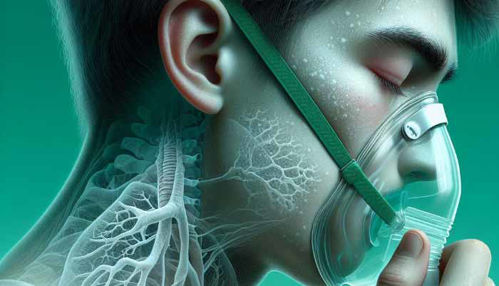A tumor is an abnormal mass anywhere in the body. Although strictly speaking, a tumor can also be a collection of pus (abscess) or inflammation; the term is usually used for an abnormal growth (neoplasm) that is either malignant (cancerous) or benign (non-cancerous).
TUMOR IN THE HEAD: General | Symptoms | Symptoms of some brain tumors | Benign intracranial hypertension or brain tumor? | Treatment | Spinal cord tumors | Questions and Answers | Sources/references
In most areas of the body, a benign tumor causes little or no problems, but in the brain, any abnormal growth can do significant damage. A tumor can damage the brain in two ways: the growing tumor can directly destroy the tissue, or, because the skull is complex and its contents cannot expand, its pressure on the brain affects even areas far from the tumor.
Spinal cord tumors can also damage vital nerve tissue by pressing on it. Neurofibromas, soft growths of abnormal nerve tissue, can damage peripheral nerves (those outside the brain and spinal cord) and nerve roots in the spine. Even cancer elsewhere in the body sometimes affects the nervous system and causes paraneoplastic syndromes.
Image: Several types of benign tumors can grow in the brain.
.jpg)
A benign brain tumor is an abnormal, but not cancerous, tissue growth in the brain. A malignant brain tumor is any cancer in the brain that is capable of invading and destroying adjacent tissue, or that has spread through the blood (metastasized) into the brain from somewhere else.
Several types of benign tumors can grow in the brain. They are named after the specific cells or tissues from which they originate: schwannomas originate from Schwann cells that form the sheath around nerves; ependymomas from cells lining the inner surface of the brain; meningiomas from the meninges, the tissue that covers the outer surface of the brain; adenomas from glandular cells; osteomas from bony structures of the skull; and hemangioblastomas from blood vessels. At birth, some benign brain tumors (e.g., craniopharyngiomas, chordomas, germinomas, teratomas, dermoid cysts, and angiomas) may be present.
Meningiomas are usually benign but can recur after removal. These tumors occur more often in women, usually between the ages of 40 and 60, but they can also start growing in childhood or later in life. The symptoms and dangers of these tumors depend on how big they are, how fast they grow, and where they are in the brain. If they get too big, they can cause a mental breakdown, very similar to dementia.
Video Content: Understanding Brain Tumor Survival Rates.

The most common malignant brain tumors are metastases from cancer that started in another part of the body. Breast and lung cancer, malignant melanoma, and blood cancers, such as leukemia and lymphoma, can all spread to the brain. The seeds can grow in a single brain area or several different areas. Primary brain tumors arise in the brain. Most often, primary brain tumors are gliomas arising from tissues surrounding and supporting nerve cells.
| Type of tumor | Origin | Grade malignancy | Percentage of all brain tumors | Who gets sick |
| glioma (glioblastoma multiforme, astrocytoma, oligodendroglioma) | supporting cells of the brain, including astrocytes and oligodendrocytes | malignant or relatively benign | 65% (depending on type) | children and adults |
| hemangioblastoma | blood vessels | benign | 1 to 2% | children and adults |
| pituitary adenoma | pituitary epithelial cells | benign | 2% | children and adults |
| Gordon | spinal cord nerve cells | benign but invasive | less than 1% | adults |
| medulloblastoma | embryonic cells | malignant | children | |
| meningioma | meningeal cells | benign | 20% | adults |
| osteoma | skulls bones | benign | 2% | children and adults |
| osteosarcoma | cranial bones | malignant | less than 1% | children and adults |
| pinealoma | pineal cells | benign | 1% | children |
| schwannoma | Schwann cells that wrap around nerves | benign | 3% | adults |
| germ cell tumors | embryonic cells | malignant or benign | 1% | children |
Several gliomas are malignant; the most common type is glioblastoma multiforme. Others include fast-growing anaplastic astrocytomas, slower-growing astrocytomas, and oligodendrogliomas. Medulloblastomas, which are rare, usually attack children before puberty. Sarcomas and adenocarcinomas are rarer types of cancer that arise from non-nervous structures. Brain tumors occur equally in men and women, but some types are more common in one sex and others in the other sex. For unknown reasons, brain lymphomas are becoming more common, especially in people who have AIDS.
Symptoms
Symptoms occur when brain tissue is destroyed or pressure develops in the brain, regardless of whether the tumor is benign or malignant. However, when the brain tumor is a metastasis from a distant malignant tumor, the patient may also have symptoms related to this cancer. Thus, for example, lung cancer causes a cough with bloody sputum, and breast cancer causes a lump in the breast.
Symptoms of a brain tumor depend on its size, how fast it grows, and where it grows. Tumors in some parts of the brain can grow to a considerable size before symptoms become apparent; in other areas, even a small tumor can have disastrous consequences.
Image: Headache is often the first symptom.
.jpg)
A headache is often the first symptom, although other causes cause more headaches than a brain tumor. Brain tumor headache usually recurs frequently, or the patient feels it constantly without relief; it is often severe, can start in someone who has never had headaches before, occurs at night, and is present in the morning when the patient wakes up.
Other common early symptoms of a brain tumor include balance and coordination disorders, dizziness, and double vision. Later symptoms include nausea and vomiting, occasionally fever, and abnormally high or low heart and breathing rates. Just before death, very severe fluctuations in blood pressure can occur.
Symptoms of some brain tumors
Astrocytomas and oligodendrogliomas can grow slowly and only cause seizures. When they are more malignant (anaplastic astrocytomas and anaplastic oligodendrogliomas), they can cause signs of abnormal brain function, e.g., weakness, loss of sensation, and dependence when walking. The most malignant astrocytoma, glioblastoma multiforme, grows so fast that it raises the pressure in the brain, causing headaches, slowed thinking, and, if the pressure is high enough, drowsiness and coma.
Meningiomas
Benign tumors that originate in the brain's coverings (meninges) can cause different symptoms depending on where they grow. They can cause weakness or numbness, seizures, an impaired sense of smell, bulging eyes, and visual disturbances. In older people, they can cause memory disorders and impaired thinking, similar to Alzheimer's disease.
Epiphyseal tumors
The pineal gland, located in the middle of the brain, controls the body's biological clock, especially the normal cycle of wakefulness and sleep. Atypical pineal tumors (germ cell tumors), which are most common in childhood, often result in early puberty. They can prevent the cerebrovascular fluid that circulates the brain from draining, leading to brain and skull enlargement (hydrocephalus) and severe disorders of brain functions.
Pituitary tumors
The pituitary gland, located at the base of the skull, controls much of the body's endocrine system. Pituitary tumors are usually benign and secrete abnormally large amounts of pituitary hormones:
- An increased amount of growth hormone causes extreme growth in height (gigantism) or disproportionate enlargement of the head, face, arms, legs, and chest (acromegaly).
- Cushing's syndrome is the result of an increased amount of corticotropin.
- An increased amount of thyroid-stimulating hormone (TSH) causes hyperthyroidism.
- The increased amount of prolactin prevents menstruation (amenorrhea), causes milk production in the breasts of women who are not breastfeeding (galactorrhoea), and increases breast size in men (gynecomastia).
Pituitary tumors can also destroy tissues that secrete hormones, which sooner or later leads to low hormone levels in the body. Other symptoms include headaches and loss of the outer parts of the visual fields of both eyes. Some brain tumors cause seizures. Attacks are more common in benign tumors, meningiomas, and slow-growing types of cancer, e.g., astrocytomas, than in fast-growing species.
Video content: Primary brain tumors | What are they, and how are they created?

Due to the tumor, one of the upper or lower limbs or one-half of the body may be weakened or paralyzed, and disturbances in the sensations of heat, cold, pressure, touch, or pricking may occur. Tumors can also affect hearing, vision, and sense of taste. Pressure on the brain can cause personality changes; the patient can become drowsy, confused, and unable to think. Such symptoms are severe and require immediate examination.
Benign intracranial hypertension or brain tumor?
Benign intracranial hypertension (also called pseudotumor cerebri) is a disease in which blood pressure increases without signs of a tumor, infection, blockage of the fluid surrounding the brain, or any other cause. It is sometimes mistaken for a brain tumor. It is most common in women between 20 and 50 years of age, especially in obese women.
In most cases, neither the onset nor the subsequent disappearance of benign cranial hypertension can be linked to any specific event. In children, it sometimes occurs after discontinuing corticosteroids, ingesting excessive amounts of vitamin A, or taking the antibiotic tetracycline.
Benign intracranial hypertension usually begins with a mild headache. Later in the disease, about 5 percent of people temporarily lose sight, wholly or partially, in one or both eyes. The doctor may also find swelling at the back of the eye, called papilledema.
The physician's first step in treating benign intracranial hypertension is to rule out all possible treatable causes of elevated intracranial pressure. CT scan results are usually expected, but images may show mild compression of air and fluid spaces in the brain. Lumbar puncture usually shows elevated cerebrospinal fluid pressure, although the fluid is normal chemically.
In about 10 to 20 percent of people with benign intracranial hypertension, the disease recurs, and in a small percentage of patients, the condition worsens, and sooner or later, they become blind. Even if the pressure in the skull is relieved, the lost vision may never be recovered. In some people with chronic benign intracranial hypertension, a joint (shunt) can be surgically inserted to drain fluid from the brain.
Blood tests show abnormal levels of pituitary hormones, and a tumor can usually be diagnosed with CT or MRS imaging. Some other tumors can also cause abnormal levels of hormones in the blood, but most tumors do not. To determine the type of tumor and decide whether it is malignant, a biopsy (a sample of the tumor is taken and examined under a microscope) must be done.
Image: The brain tumor treatment depends on its location and type.
.jpg)
Sometimes, a microscopic examination of the cerebrospinal fluid obtained during a lumbar puncture shows cancer cells. A lumbar puncture should not be performed if there are any signs of increased intracranial pressure, because a sudden change in pressure could cause herniation, one of the most common complications of a brain tumor.
In a herniation, increased pressure in the skull pushes the brain tissue down through a narrow opening at the skull's base, compressing the brain's lower part (brainstem). As a result, the brainstem's most important functions—breathing, heart rate, and blood pressure—are disrupted. If the herniation is not detected and treated immediately, it will eventually end in coma and death.
A biopsy can usually be done during surgery, in which all or part of the tumor is removed. Sometimes, tumors in deep parts of the brain are inaccessible and cannot be approached safely and directly. In such cases, we can perform a biopsy with stereotactic surgery, a three-dimensional method. In this method, a special preparation is used for imaging; we guide the introduction of the needle into the tumor, and then we absorb the tumor cells into it.
Treatment
Treatment of a brain tumor depends on its location and type. If possible, the tumor is surgically removed. Many brain tumors can be removed without causing significant or any damage to the brain. However, some grow in areas where removal is difficult or impossible without destroying essential structures. The surgery sometimes causes brain damage, which can cause partial paralysis, changes in sensation, weakness, and intellectual impairment.
However, tumor removal is essential if its growth threatens important brain structures. Even if surgical removal cannot cure cancer, surgery can be beneficial because it reduces the size of the tumor, relieves symptoms, and helps the doctor determine the exact type of tumor and whether other types of Treatment are warranted, e.g., healthy Treatment with radiation.
Some benign tumors must be surgically removed because their continued growth in a confined space can cause severe damage or death. Meninges are usually removed, but they can generally be removed safely and completely. Very small meningeal and meningiomas in elderly people can be left alone. We similarly treat most other benign tumors, such as schwannomas and ependymomas. Sometimes, after surgery, radiation is used to destroy the remaining tumor cells.
Video content: Idiopathic intracranial hypertension.

Most brain tumors, especially those that are malignant, are treated with a combination of surgery, radiation, and chemotherapy. After we remove as much of the tumor as possible, we start radiation treatment. Radiation therapy rarely cures brain cancer, but it can shrink the tumor so much that it can be controlled for months or even years. We use chemotherapy to treat some forms of brain cancer. Both metastatic and primary types of brain cancer can respond to chemotherapy.
Increased pressure on the brain is severe and requires immediate medical attention. Doctors usually inject the patient with drugs that lower the pressure and prevent herniation, e.g., mannitol and corticosteroids. Sometimes, they place a small device under the skull to measure the pressure on the brain so that the Treatment can be adjusted to the pressure.
Treatment of metastases in the brain depends mainly on where the cancer originates. Cancerous growths in the brain are often irradiated. Surgical removal may benefit the patient if he has a single tumor. In addition to traditional methods of Treatment, doctors are testing some experimental types of Treatment, which include chemotherapy, radioactive implants in the tumor, and radiosurgery.
Spinal cord tumors
Spinal cord tumors are benign or malignant neoplasms in the spinal cord. Tumors in the spinal cord can be either primary (originating in the spinal cord) or secondary (seeds of cancer that arose elsewhere in the body). Spinal cord tumors are much less common than brain tumors and are uncommon in children. Only about 10 percent of primary spinal cord tumors originate in nerve cells within the spinal cord.
Two-thirds of these tumors are meningiomas (from the meningeal cells surrounding the brain and spinal cord) and schwannomas (from the Schwann cells surrounding the nerves). Both meningiomas and schwannomas are benign (non-cancerous) growths. Malignant (cancerous) growths include gliomas, which arise from other cells in the spinal cord, and sarcomas, which arise from connective tissues in the spine.
Image: Tumors in the spinal cord can be either primary or secondary.
.jpg)
Neurofibromas, which are a type of schwannoma in which Schwann cells develop into tumors, can also arise in the spinal cord as part of von Recklinghausen's disease. Metastases spread to the spinal cord or nearby structures from malignant tumors in other body areas, most commonly in the lung, breast, prostate, kidney, or thyroid. Lymphomas can also spread to the spinal cord.
Questions and answers
How common is a tumor in the head?Sources and references
Extensive health manual for home use, Youth Book Publishing House
- 72 Must-Know Brain Tumor Statistics (2024) - https://www.aaroncohen-gadol.com/
- Brain Tumor: Statistics - https://www.cancer.net/
- Brain Tumor: Risk Factors - https://www.cancer.net/
- Brain Tumors and Brain Cancer - https://www.hopkinsmedicine.org/
- Benign brain tumor - https://www.nidirect.gov.uk/













